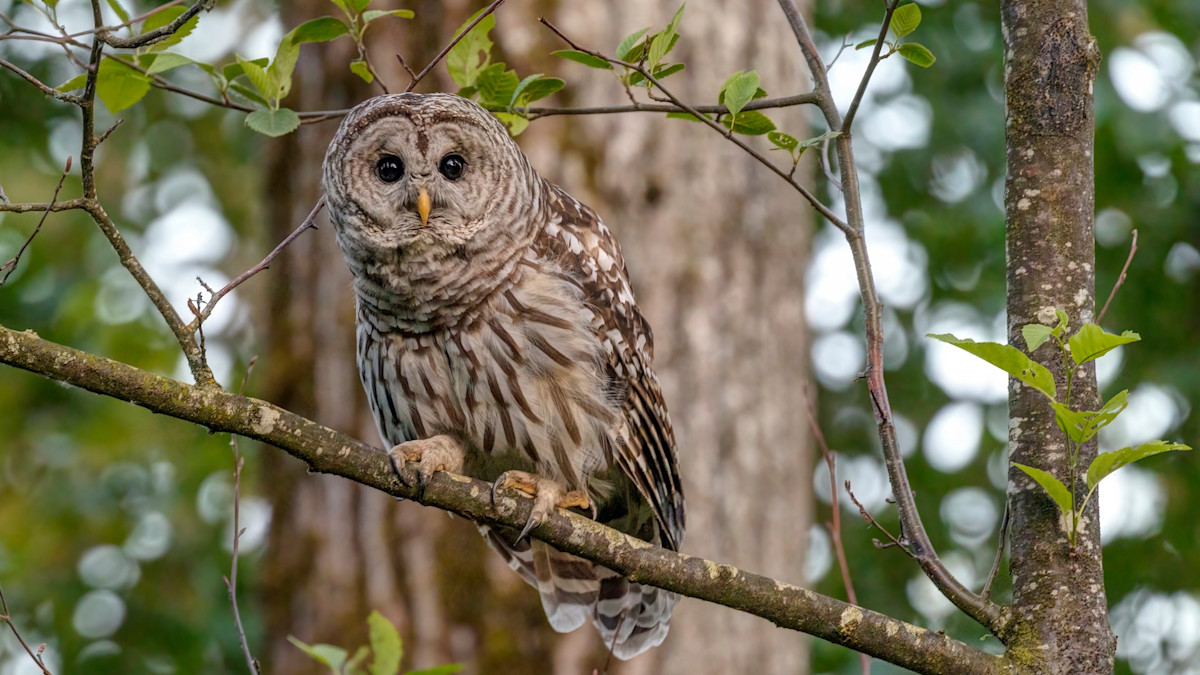
When you think of bird hunting, what comes to mind? Ducks? Pheasants? Maybe turkeys? It’s unlikely that owls make the list for most hunters, but that could change in the Pacific Northwest (PNW), where the US Fish and Wildlife Service (USFWS) is in the final stages of a proposal to kill 500,000 barred owls in the region over the next 30 years.
The purpose of the culling is to protect spotted owls, which are endangered in Washington and threatened in Oregon and California. Their populations have been in decline for decades across the PNW, with populations in the Olympic and Cle Elum areas marking almost 8% annual declines at their peaks. Historically, the main threat to the owls was old-growth logging, which was rapidly destroying critical habitat. It resulted in forest protection measures first put in place in the 1990s, setting guidelines for the number of trees that could be removed near spotted owl nesting sites. At the time, the measures outraged the logging industry but successfully stabilized populations.
The owls weren’t in the clear, though. The threat of logging was quickly replaced by another: barred owls. The slightly larger species is native to the east coast but has been expanding in range. Barred owls arrived in the Pacific Northwest in the 1970s. Though their western expansion route is not entirely known, it’s thought to have tracked through the boreal forests of Canada and then dipped south again on the Pacific coast.
Ever since, though, they’ve been outcompeting spotted owls for food and habitat. The primary threat is an overlap in prey—both species primarily eat nocturnal rodent species, and there aren’t enough to go around. Spotted owls also disrupt the natives’ nesting areas, causing further stressors at the population level.
Some conservation groups see the USFWS’s proposed culling plan as a necessary, last-ditch effort to save the spotted owls. And indeed, there’s evidence that culling is an effective tactic to do so.
In 2021, researchers at Oregon State University published a paper arguing the effectiveness of killing barred owls as a conservation strategy for spotted owls. The paper was based on a five-year study in which the researchers chose five field sites across the Pacific Coast from Washington to California, and created control and treatment plots at each site.
The scientists left the control plots undisturbed but shot all the barred owls they could in the treatment plots with 12-gauge shotguns. In most plots, the researchers killed a few hundred owls, but in one plot, they killed just over 1,000.
The researchers concluded that culling the invasive owls resulted in a significant improvement in spotted owl survival in the study areas: “While suppression of barred owls can be difficult, costly, and ethically challenging, improvements in vital rates and population trends of spotted owls, and perhaps other threatened wildlife, can be expected when densities of barred owls are reduced from current levels,” the authors of the study stated.
Some, however, are still skeptical of the culling plan. Bob Sallinger, executive director of Bird Conservation Oregon is one of the skeptical. “We think this plan will result in a tremendous number of dead barred owls but likely won’t save the spotted owl. The rigor in terms of the training, the requirements, the oversight and accountability isn’t there and if just a fraction of the birds shot turn out to be spotted owls, the outcome would be devastating,” Sallinger told the Seattle Times. “Our recommendation was they really needed to go back and rethink this with something much more targeted and sustainable.”
Under the current proposal, all removals must be completed by trained professionals. While there was talk of allowing the general public to hunt barred owls during the drafting process, it was decided against in the final proposal. Instead, all killings must be performed by “removal specialists,” who are trained in owl identification. Based on the removal protocol, however, it appears anyone can become a “removal specialist,” but as prerequisites, they must demonstrate owl identification knowledge and tag along with an existing specialist until deemed “ready for independent removal.” For most hunters, that’s likely an insurmountable barrier to entry.
Regardless of culling methods, the USFWS believes that spotted owls are at extreme risk without some kind of human intervention. “Without actively managing barred owls, northern spotted owls will likely go extinct in all or the majority of their range, despite decades of collaborative conservation efforts,” USFWS Oregon supervisor Kessina Lee said in a press release. “The Service has a legal responsibility to do all it can to prevent the extinction of the federally listed northern spotted owl and support its recovery,” she continued.
The USFWS is expected to release a final decision notice within the next 30 days. If the plan is adopted, the Service would need a permit under the Migratory Bird Treaty Act to implement it. Then it’s (somewhat) open season on barred owls in the PNW.




